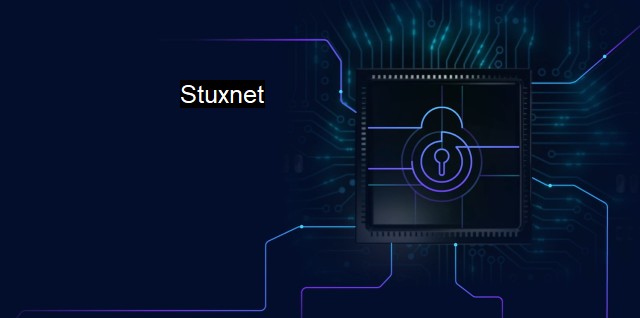What is Stuxnet?
Stuxnet: The Malware That Unleashed Physical Destruction and Shook the Industrial World
Stuxnet is a computer worm virus that was first identified in June 2010. by analyzing its sophisticated implementation and aggressive behavior which consists mainly of harming industrial applications via programmable logic controllers (PLCs), experts believe Stuxnet might have been active as early as 2005. This malicious worm was different in many aspects, and it was infamous for several reasons. The most notable one is Stuxnet infecting and causing immense damage to the nuclear program of Iran.Aptly defined, Stuxnet is a highly sophisticated piece of malware, which stands for malicious software, potentially developed by national-level resources. To understand Stuxnet, it is crucial to appreciate the complexity of its creation, its implementation, and the overall impact it had on cyber warfare and cybersecurity standards worldwide.
What makes Stuxnet unique is its assembly, most experts concurred that a team of programmers worked for months, possibly years on this project. Considering this feat, common perception concedes the actors who designed and deployed Stuxnet are likely to be state-associated or have significant resources at their disposal.
One of the primary features of Stuxnet was its ability to spread itself via Windows machines with the objective of finding Siemens Step7 software. Step7 software is a tool developed by Siemens to create, simulate, and virtually test automation systems before they execute tasks in real-time. The step7 software is mainly found installed in manufacturing facilities, where they control PLCs responsible for managing various aspects of industrial operations.
Stuxnet exploited four zero-day vulnerabilities, what's particularly interesting to note is that these zero-day vulnerabilities were not common knowledge, indicating the resource and commitment behind identifying and appropriating these backdoors. The term 'zero-day' signifies the vendor of the software has 'zero days' to fix the vulnerabilities since they are already attacked. The four zero-day vulnerabilities used by Stuxnet signify the immense resource commitment expended in this virus creating a ripple in the cybersecurity space globally.
Once on a Windows computer, Stuxnet implemented a match-and-destroy strategy; it meticulously scoured the operating system of any affiliated Siemens software and started reversing the platform's operations, directly under the nose of majority antivirus and security products of that period.
Stuxnet's focus on disrupting industrial controls changed the view of cybersecurity, leaning the discipline more toward the implications in the real world, affecting entire industries or national security. it also showed that cyberattacks could become weapons of economic warfare in the future.
Stuxnet's behavior suggests that the malware was developed to impede Iran's nuclear program. The malware would make centrifuges (critical components of a nuclear facility) spin rapidly out of control, and then it would disguise this behavior from monitoring systems, leading to the centrifuges' failure.
The implications of this disruptive act significantly degraded several key components of Iran's nuclear infrastructure, delaying their progress in achieving nuclear material benchmarks. The deployment outcome and the detailed design of the Stuxnet virus infer the magnum scale strategic and tactical planning undertaken by its authors, and states' true capabilities when national security concerns arise.
The global antivirus and cybersecurity industry has since taken notice after the discovery of Stuxnet. Most cybersecurity solutions have increased their capabilities to detect such advanced, highly sophisticated threats and ensure the timely protection of data, systems, and essential infrastructure. Countermeasures initiated include developing stringent vulnerability testing mechanisms, dedicated threat-hunting features, and boosting cyber defense capabilities on national levels.
Where Stuxnet was considered a black swan at that moment, it eventually led to the global transformation of cybersecurity policies, effectively shuffling focus towards evolving threats tied up with infrastructure or industrial systems. The effect of Stuxnet on cybersecurity serves as a stern reminder that there is an urgent and constant need for comprehensive tightly-knit security practices to protect our digital and physical world, and reinforces the emergence of the global cybersecurity landscape of today.

Stuxnet FAQs
What is Stuxnet?
Stuxnet is a malicious computer worm that targeted industrial control systems, particularly those used in nuclear facilities. It was discovered in 2010 and is considered one of the most sophisticated cyber attacks to date.How did Stuxnet work?
Stuxnet spread through infected USB drives and exploited zero-day vulnerabilities in Windows operating systems. Once it infected a computer, it searched for specific software used in industrial control systems and targeted them for attack. It caused physical damage by manipulating the programmable logic controllers (PLCs) that control industrial machinery.Who was behind the Stuxnet attack?
The creators of Stuxnet have never been officially named or confirmed, but it is believed to be a joint effort between the United States and Israel. The attack was likely motivated by a desire to disrupt Iran's nuclear program.How did antivirus software respond to Stuxnet?
Antivirus software initially struggled to detect Stuxnet because it was designed to hide itself and avoid detection. However, once the existence of the worm was discovered, antivirus companies quickly took action to update their software and protect against it. As with any cyber attack, it is important to regularly update your antivirus software and practice good cybersecurity habits to minimize your risk of infection.| | A | | | B | | | C | | | D | | | E | | | F | | | G | | | H | | | I | | | J | | | K | | | L | | | M | |
| | N | | | O | | | P | | | Q | | | R | | | S | | | T | | | U | | | V | | | W | | | X | | | Y | | | Z | |
| | 1 | | | 2 | | | 3 | | | 4 | | | 7 | | | 8 | | |||||||